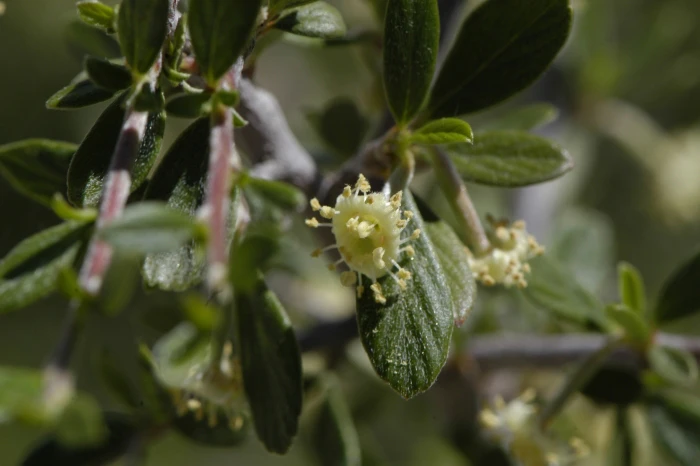Desert Mountain Mahogany
(Cercocarpus breviflorus)
Desert Mountain Mahogany (Cercocarpus breviflorus)
/
/

© Elliott Gordon
CC BY 4.0
Image By:
© Elliott Gordon
Recorded By:
Copyright:
CC BY 4.0
Copyright Notice:
Photo by: © Elliott Gordon | License Type: CC BY 4.0 | License URL: http://creativecommons.org/licenses/by/4.0/ | Uploader: egordon88 | Publisher: iNaturalist |
























Estimated Native Range
Climate Requirements for Wake Forest, North Carolina
| This Plant | Your Site | Plant Suitability for Your Location | ||
|---|---|---|---|---|
| • Precipitation | 9" - 36" | 45" | Aquatic | Aquatic |
| • High Temp. | 63°F - 101°F | 90°F | Your summer temperatures are normal for this plant. | Excellent |
| • Low Temp. | 3°F - 44°F | 28°F | Your winter temperatures are normal for this plant | Excellent |
This plant may not grow well at your location - your precipitation is too high.
Summary
Cercocarpus breviflorus, commonly known as Desert Mountain Mahogany, is an evergreen tree or large shrub native to the semi-arid regions of the southwestern United States and northern Mexico. It typically grows up to 16 feet tall and is characterized by its small, oblong, leathery leaves and its inconspicuous yellowish-green flowers which bloom in the spring. The fruits are distinctive achenes with long, feathery, hairy styles that persist into winter, adding visual interest. Desert Mountain Mahogany is adapted to dry mountainous areas with well-drained soils, often on limestone and igneous rock substrates, and is commonly associated with pinyon pine, juniper, and various shrubs in chaparral and pinyon-juniper woodland ecosystems.
This species is valued for its drought tolerance and ability to thrive in poor soils, making it an excellent choice for xeriscaping and naturalistic plantings in arid regions. It is also used for erosion control and as a windbreak due to its sturdy nature. In cultivation, it requires minimal maintenance once established, needing little water and tolerating full sun to partial shade. While not commonly afflicted by diseases, it can occasionally suffer from root rot if overwatered. Desert Mountain Mahogany is not typically grown for its flowers, which are not particularly showy, but its silvery-gray bark and feathery fruits provide year-round visual interest.CC BY-SA 4.0
This species is valued for its drought tolerance and ability to thrive in poor soils, making it an excellent choice for xeriscaping and naturalistic plantings in arid regions. It is also used for erosion control and as a windbreak due to its sturdy nature. In cultivation, it requires minimal maintenance once established, needing little water and tolerating full sun to partial shade. While not commonly afflicted by diseases, it can occasionally suffer from root rot if overwatered. Desert Mountain Mahogany is not typically grown for its flowers, which are not particularly showy, but its silvery-gray bark and feathery fruits provide year-round visual interest.CC BY-SA 4.0
Plant Description
- Plant Type: Shrub, Tree
- Height: 4-15 feet
- Width: 4-10 feet
- Growth Rate: Moderate
- Flower Color: White
- Flowering Season: Spring, Summer
- Leaf Retention: Evergreen
Growth Requirements
- Sun: Full Sun, Part Shade
- Water: Low
- Drainage: Fast, Medium
Common Uses
Bank Stabilization, Bird Garden, Drought Tolerant, Fire Resistant, Low Maintenance, Showy Flowers
Natural Habitat
native to the semi-arid regions of the southwestern United States and northern Mexico
Other Names
Common Names: Grey Leaf Mountain Mahogany, Wright’s Mountain-Mahogany, Hairy Cercocarpus, True Mountain Mahogany
Scientific Names: Cercocarpus breviflorus, Cercocarpus breviflorus var. eximius, Cercocarpus eximius, Cercocarpus montanus var. paucidentatus, Cercocarpus parvifolius var. paucidentatus, Cercocarpus paucidentatus
GBIF Accepted Name: Cercocarpus breviflorus